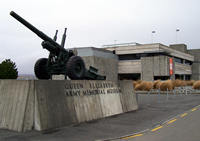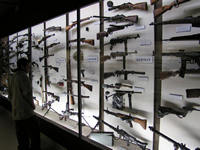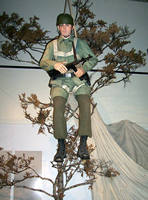|
The Desert
Road and Waiouru Army
Museum
Central
Plateau Pictures
TikiTouring
review of Chateau Tongariro
Book
a stay at the Chateau Tongariro
Pictures
of the Chateau Tongariro
Taupo Highlights
What's
to do in Taupo
Rotorua Highlights
Adventure in Rotorua
Photos of Rotorua
Adventure Photos of Rotorua
Sightseeing,
Tours, Attractions and Events in Rotorua
Hotels
and Accommodation in Rotorua
By
Richard Moore
 The
central plateau of New Zealand's North Island is famous for its
proximity to some terrific ski fields - such as Turoa
and Whakapapa - and the wild terrain of the
Desert Road. The
central plateau of New Zealand's North Island is famous for its
proximity to some terrific ski fields - such as Turoa
and Whakapapa - and the wild terrain of the
Desert Road.
The
rugged nature of the central plateau makes it the perfect place
to have a major training area for the army and there are plenty
of signs around telling you it is dangerous to get off the main
road at certain places.
Speaking
of the New Zealand army there is an excellent museum at the town
of Waiouru on the Desert Road. If you are driving to or from the
snow slopes, or are on your way to somewhere else, then a few hours
spent at the Waiouru Army Museum
is recommended for those who like history.
 The
army museum is located in an imposing building that gives little
idea as to what is inside, however, the tanks and artillery pieces
surrounding it offer a pretty good clue as to its raison d'etre. The
army museum is located in an imposing building that gives little
idea as to what is inside, however, the tanks and artillery pieces
surrounding it offer a pretty good clue as to its raison d'etre.
Within
its walls exhibits and displays cover the entire range of New Zealand's
participation in war, from the Maori Wars through to the peacekeeping
operations Kiwi troops are currently engaged in.
The
Waiouru Army Museum is laid out in a chronological order of conflict
and this guides you through the military history of a nation that
has spent a lot of time fighting side by side with Australian troops.
But
New Zealand had its own major war when the local Maori tribes fought
back against European settlement in what was known as the Maori
Wars, but is now the more PC Land Wars.
 The
Maoris gave one heck of a good account of themselves militarily
and used not only guerrilla tactics to great effect, but also perfected
the art of trench warfare a generation before the slaughterhouse
of World War One. The
Maoris gave one heck of a good account of themselves militarily
and used not only guerrilla tactics to great effect, but also perfected
the art of trench warfare a generation before the slaughterhouse
of World War One.
From
there it is the Boer War in South Africa where, like Aussies, Kiwis
fought overseas for their first major conflict. Next up it's World
War One and Gallipoli, the Second World War - the campaigns in Greece,
Crete, North Africa and the Pacific - Korea, Malaya, Vietnam and
service with the United Nations.
The
various displays include militaria, dioramas, weapons, uniforms,
personal stories and large scenes using life-size models and military
hardware such as tanks and armoured cars.
One
of the most impressive, if not the best collection on show, is the
Army Museum's medal alcove where they display many top ranking awards
including Victoria Crosses the highest Commonwealth award for bravery
in the face of the enemy cast in the metal of Russian cannons captured
during the Crimean War.
 The
most poignant part of the museum is the Tears on Greenstone waterwall
that represents every New Zealander who has died in war. The
most poignant part of the museum is the Tears on Greenstone waterwall
that represents every New Zealander who has died in war.
It is a wall - the largest jade structure in the Southern Hemisphere
- with a veil of water representing grief and new life. The names
of those killed are spoken in alphabetical order.
On
a more commercial aspect, the Army Museum has a cafeteria and gift
shop on site, as well as a military archive and research library.
The Army Museum Waiouru is open 9.00 am - 4.30pm every day, except
Christmas Day.
Admission
Prices
|



